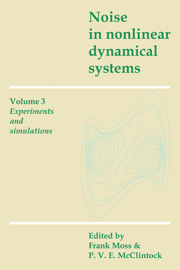Book contents
- Frontmatter
- Contents
- List of contributors
- Preface
- Introduction to Volume 3
- 1 The effects of colored quadratic noise on a turbulent transition in liquid He II
- 2 Electrohydrodynamic instability of nematic liquid crystals: growth process and influence of noise
- 3 Suppression of electrohydrodynamic instabilities by external noise
- 4 Colored noise in dye laser fluctuations
- 5 Noisy dynamics in optically bistable systems
- 6 Use of an electronic model as a guideline in experiments on transient optical bistability
- 7 Computer experiments in non-linear stochastic physics
- 8 Analogue simulations of stochastic processes by means of minimum component electronic devices
- 9 Analogue techniques for the study of problems in stochastic nonlinear dynamics
- Index
7 - Computer experiments in non-linear stochastic physics
Published online by Cambridge University Press: 05 January 2012
- Frontmatter
- Contents
- List of contributors
- Preface
- Introduction to Volume 3
- 1 The effects of colored quadratic noise on a turbulent transition in liquid He II
- 2 Electrohydrodynamic instability of nematic liquid crystals: growth process and influence of noise
- 3 Suppression of electrohydrodynamic instabilities by external noise
- 4 Colored noise in dye laser fluctuations
- 5 Noisy dynamics in optically bistable systems
- 6 Use of an electronic model as a guideline in experiments on transient optical bistability
- 7 Computer experiments in non-linear stochastic physics
- 8 Analogue simulations of stochastic processes by means of minimum component electronic devices
- 9 Analogue techniques for the study of problems in stochastic nonlinear dynamics
- Index
Summary
Introduction
This chapter is devoted to developing digital techniques to integrate multidimensional stochastic differential equations. A variety of different spectral densities of the stochastic forcing can be achieved with the algorithms presented.
Very often (for example, when several dimensions are involved, or an external deterministic forcing is present, or fluctuation–dissipation relations do not hold for the physical system modelled by the set of stochastic differential equations) a digital simulation is the only viable way of extracting the detailed information one is looking for. Also, digital techniques can simulate the theoretical model in a sort of ideal environment, where everything is under control and no non-idealities are present. It is actually the author's personal belief that digital simulation in stochastic physics should be thought of as a theoretical tool, like, say, Padé approximations or steepest descents, and it should be considered as the natural complement of modelling.
The chapter is organized as follows: in Section 7.2 a general algorithm for integrating sets of autonomous differential equations in the presence of just one external stochastic forcing is derived. In Section 7.3 the algorithm is generalized to include non-autonomous differential equations and multidimensional external forcings. Sections 7.4 and 7.5 contain applications to, respectively, overdamped and underdamped non-linear oscillators: what is presented in these two sections should be regarded as examples of digital simulation capabilities, and papers cited there should be consulted for more details and references.
- Type
- Chapter
- Information
- Noise in Nonlinear Dynamical Systems , pp. 189 - 221Publisher: Cambridge University PressPrint publication year: 1989
- 10
- Cited by



